Russian squads in battle. Part of 5
All armor, helmets, bracers, leggings, shields are denoted by the general term "protective weapons." Protective weapons were known to people from ancient times. In the examples of primitive tribes that were able to exist before 20 and even the beginning of 21 centuries, we know that the ancients knew defensive weapons. This is the simplest wooden shields, and the first armor made of leather, wooden or bone plates. As soon as a person got acquainted with the metal, they began to make not only offensive, but also protective weapon.
In the IX - X centuries. a complete set of iron protective weapons was expensive and rare. Later, as handicraft production developed, armor became a more widespread phenomenon. However, even then, full-fledged defensive armament remained mainly belonging to the military elite — princes, boyars, and their combatants. The main type of protective armament of a simple militia remained a wooden shield. But with the growth of handicraft production in the cities, the percentage of heavily armed soldiers in the Russian army was constantly growing.
The Chain. This type of protective weapons appeared in 1 thousand. BC. e. and was known in the Middle East and in the Roman Empire. For a long time it was believed that with the fall of Rome the chain mail in Western Europe was forgotten and it was re-mastered only during the Crusades, when the knights saw its advantages during the wars with the Muslims. But then it turned out that this view is wrong. Ringed armor was widely known in the early Middle Ages on the territory of Great Scythia - Sarmatia, from the Carpathians to the North Caucasus, Prikamye and Priural. Kolchu were distributed in the "barbaric" Europe, including Scandinavia.
Early mail had the appearance of a short shirt with sleeves (up to 70 cm long), which usually reached to the elbows. The section of the collar was located in the middle of the neck or was shifted to the side, the collar reached 10, see. The outer diameter of its rings reached 10-11 mm. The advantage of the old Russian chain mail was its relative lightness and flexibility. She did not constrain the movements of a warrior, while being a good defense. The average weight of the Russian short chain mail X - XIII centuries. was about 6-7 kg.
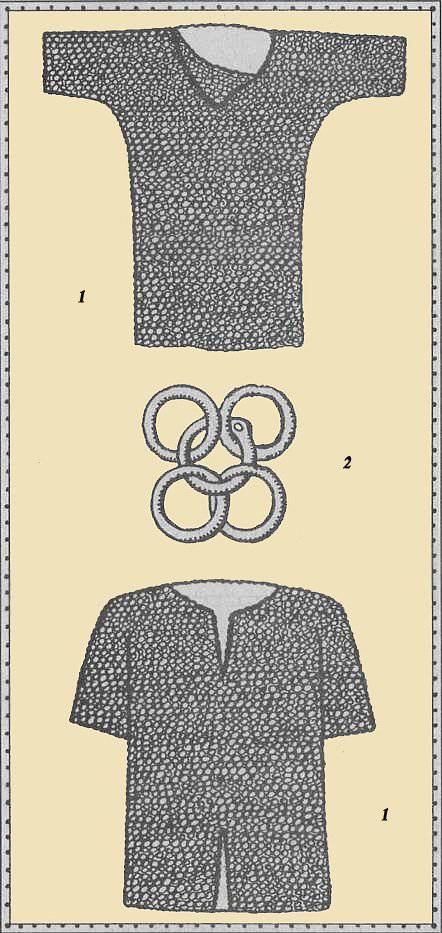
1. Russian chain mail. IX – XIII century. 2. Weaving elements from one riveted and four welded rings. Source: We are Slavs! Encyclopedia.
Eastern Slavs in the VIII - X centuries. they themselves produced chain mail. Apparently, he became the heirs of the traditions of the Sarmatian-Alanian era. Chain armor made by Russian masters of the X century, through Volga Bulgaria fell into distant Khorezm. After some time, the Russian chain mail received recognition in Western Europe. On the territory of Russia, archaeologists have found more than a hundred chain mails of the 9th - 13th centuries. of these, about 40 integers. “Ringed armor” (the word “mail” was first recorded in written sources of the 16th century) was composed of about 20 thousand rings of 6 - 13 across, with a thickness of 0,8 - 2 mm. For the manufacture of only one such "shirt" required about 600 m wire. When using another technology, the rings were not made from wire, but were cut from an iron sheet with a special stamp. The rings were usually of the same diameter. But in later times they began to combine rings of different sizes, closing the most important places of the body with small weaving. Some rings were welded tightly. Every four of these rings were connected by one open, which then riveted. Before the Batu invasion in Russia, chain mail from flattened links appeared - “baidans” and mail stockings - “nagavitsy”.
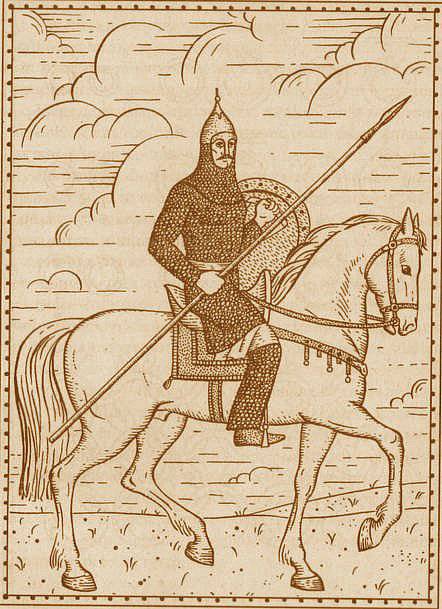
Horseman in chain mail and nagovitsah.
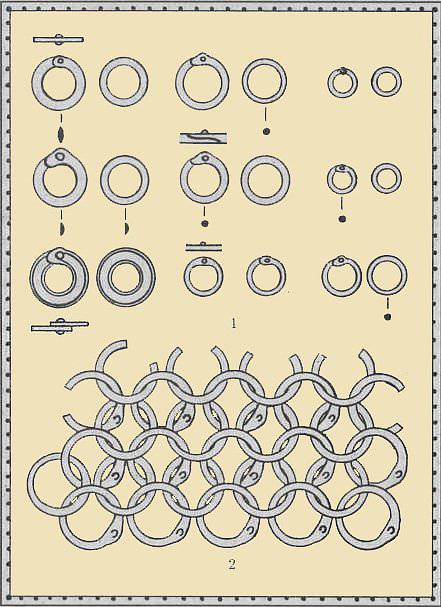
1. Ring mail. VIII – XIII century. 2. Weave from welded and riveted rings.
Carapace (plate armor). For a long time it was believed that the plate armor - “armor board”, the Russian met no earlier than the XII century. However, pictorial sources brought to us images of armor, which, as a rule, are shown in the form of scales. And in the chronicle story about how the Pechenegs first came to Russian land in 968, it was reported that voivode Pretich exchanged gifts with the Pecheneg prince and there was armor among the Russian gifts. In the 1948 year in Novgorod, steel plates were found in the 11 layer of the century. These were fragments of lamellar armor. Soon, similar finds were made in other ancient Russian cities. In IX - XII the chain mail prevailed in the protective equipment of Russian soldiers. For about every four chain mails found, there are fragments of just one shell. In the XII - XIII centuries. with the development of offensive and defensive weapons, chain mails begin to give way to lamellar armor. So, in the same Novgorod in the layers of the XIV - XV centuries. already on nine remnants of lamellar armor there is one piece of chain mail. It should be noted that the "Mongolian" conquerors used the same plate armor.
Lamellar armor, like chainmail, is a legacy of an older era. He was known in the Middle East still in 2 thousand BC. e. and this type of armor was widespread throughout Eurasia, including the skifosibirsky world and the Far East. In Russia, “armor boards” are known from the period of the formation of the state of Rurikovich and are another legacy of Scythia.
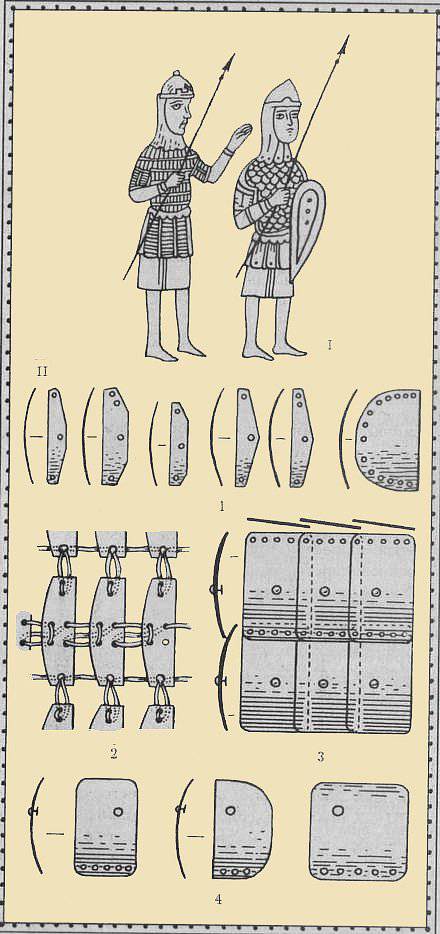
I. Warriors in plate and scaly shells. With the stamp of the living icon "St. George". The beginning of the XIV century.
Ii. Details of protective clothing (VIII – XIV century): 1 - details of lamellar armor, 2 - fastening of parts of lamellar armor, 3 - fastening of scaly armor, 4 - details of scaly armor.
The armor is an armor collected from small plates (it is also called lamellar). The plates of the armor were tied together by straps, passed through small holes at the edges of the plates. The plates came one after another, so the impression of scales, and in the places of overlay plates, protection was double. In addition, the plates were made curved, which should have been better to divert or soften the blows.
The most ancient system, which lasted very long on the territory of Russia, did not require a leather base. Elongated rectangular metal plates of 8 (10) x 1,5 (3,5) cm size were tied with straps. Judging by the visual sources, such a shell reached the hips and was divided by height into horizontal rows of tightly compressed plates.
Another type of armor was scaly armor. The plates were almost square - 6 x 4 (6) cm, and were tied to a leather or thick cloth basis. The plates moved toward each other. In such a shell was 600 - 650 plates. So that the plates do not bristling from the impact or during sudden movement, do not move away from the base, they are still fastened to the base with another - two central rivets. Such a shell, in contrast to the “belt weaving” system, was more ductile. Plates of scaly shells are found in layers of the XIII - XIV centuries. In the drawings, scaly armor is found from the XI century.
In addition, combined armor existed in Russia. For example, mail on the chest, and scaly on the sleeves and hem. Very early on, other protective elements appeared in Russia - bracers, elbow pads and leggings. Bracers defended the warrior’s hand from wrist to elbow. One such brace was found during the excavation of the southern Russian settlement Sakhnovka. Sakhnovka bracelet double wing - a long rounded sash covered the warrior’s hand outside, a short rectangular one protected the wrist. Wristband fastened on the hand with straps.
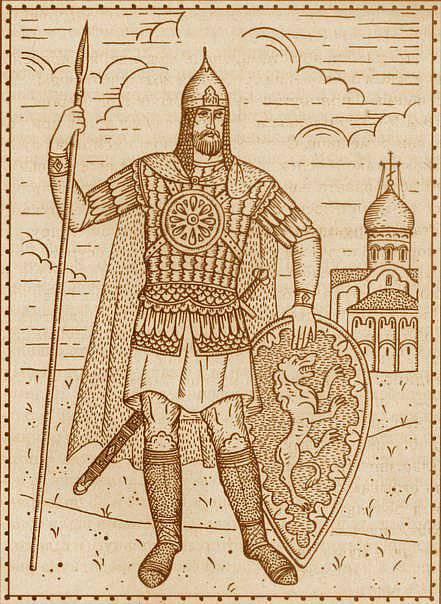
Warrior in combined armor.
Helmet. Helmets VI - VIII centuries. in the territory of Eastern Europe, archaeologists have not yet discovered. One of the oldest - a helmet of conical shape was found in the mound of the X century. The ancient blacksmith forged it from two parts and connected the strip with a double row of rivets. The bottom edge was covered with a hoop, on which there were loops for the barmitsa - a chainmail net that covered the neck and head from the back and sides. The learned world of the 19 century was quick to call Scandinavian (Norman). It soon became clear that such helmets were spread over a large area. Scandinavians used other types of helmets. Conical helmets were of Oriental origin.
However, conical helmets in Russia did not receive mass distribution. Sphero-conical helmets date back to the 10th century, and they were better able to deflect blows. These helmets were usually made of several, most often four plates with a thickness of 1,2 — 1,7 mm, which were found on each other and joined by rivets. At the bottom of the helmet with a rod, which was inserted into the loops, secured barmitsa. Most of the helmets of this type clearly belonged not simple soldiers. Iron plates figuratively carved, covered with gold and silver. The elongated top of the helmet sometimes ended in a sleeve for a sultana for feathers or dyed horsehair.
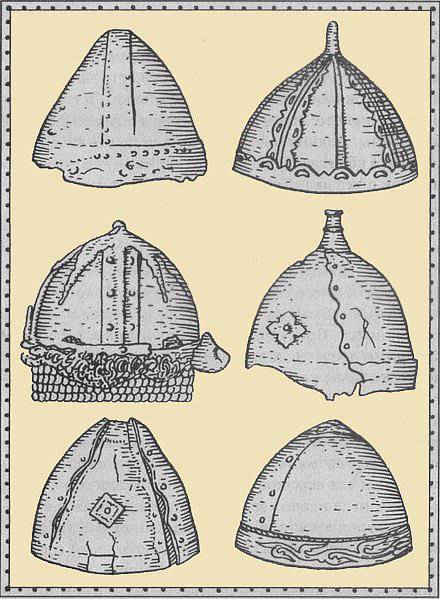
Conical, sphere-conical and dome-shaped helmets of the 10th – 13th centuries.
Another type of helmet, which was distributed in Russia in the XI - XIII centuries. - This is a high "bell-shaped" sphere-conical helmets with eye filets and nose pads. This helmet is very popular with artists depicting ancient warriors. In addition, in the lands of the "black hoods" they wore four-sided helmets with platbands - masks that covered the entire face. Such helmets appeared in the 12 century.
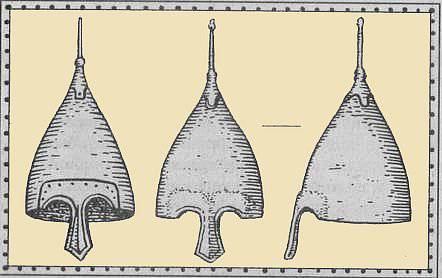
Bell-shaped sphero-conic helmets with eye fillets and nose pads. XI – XIII century.
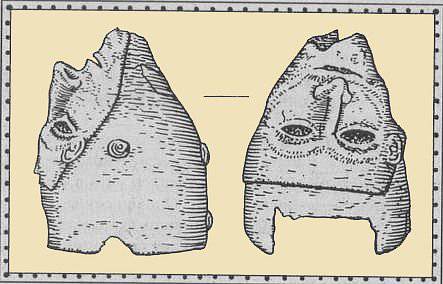
Helmet with a mask. XIII century.
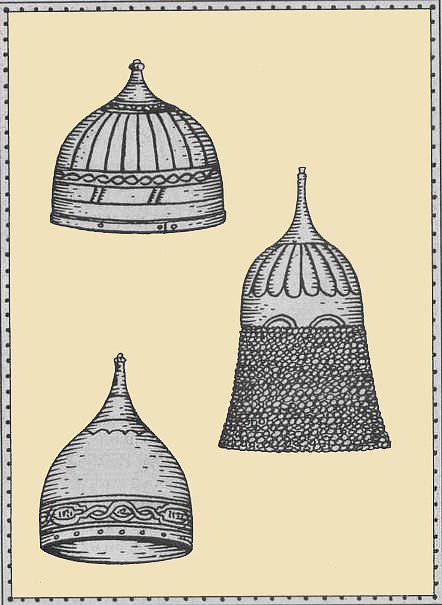
Shishaki.
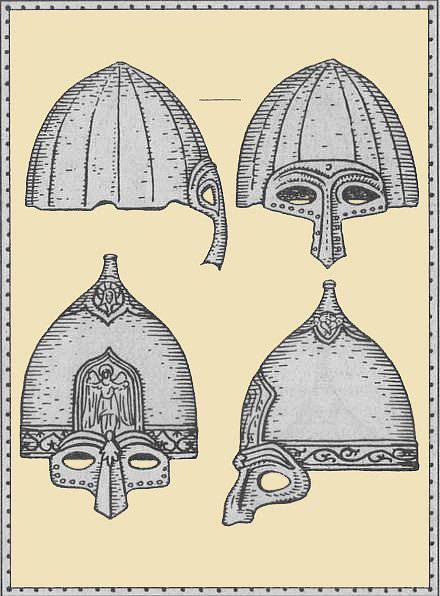
Helmet with a half mask, nose mask and eye cups. XII – XIII century.
Sphero-conical helmets of the Ancient Russian state gave rise to the later Moscow "Shishak". At the turn of the 12-13 of centuries, a type of steep dome-shaped helmet with a half mask — eye cups and nose pads was developed. We must not forget some important details of the ancient Russian helmets. This is a soft lining, it was usually made of fur, it was needed for convenience - it is not very pleasant to put an iron object directly on the head, and to soften the blows of the enemy. The sleeves were supplied with straps for fastening under the chin. Otherwise, the helmet could just fly off the head from a sudden movement, not to mention a strike in battle.
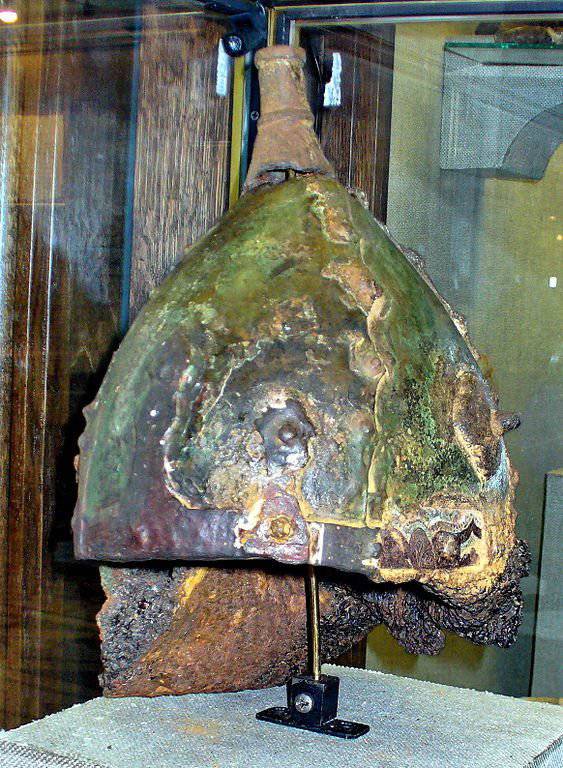
Helmet from the mound Black Grave, X century.
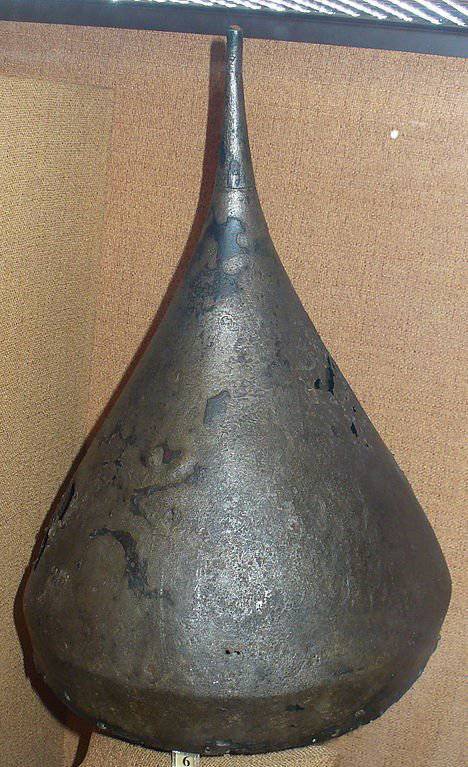
Russian Shel XVI century.
Shield. Slavic warriors love to portray armed almond-shaped shields. However, this is a mistake. Archeological data show that in the VIII - X centuries. the Rus, like their neighbors, had round shields, usually a meter across. Archaeologists have found that the ancient shields were flat and consisted of several wooden plates - about 1,5 cm thick, which were joined together, covered with leather and fastened with rivets. On the outer surface of the shield, especially on the edge, were iron fittings. In the middle of the shield was a hole that covered a convex metal plaque, which reflected the blow (“umbron”). Umbons had a hemispherical and sphero-conical shape.
On the inside of the shield they fastened the belts into which the warrior passed the arm. There also had a solid wooden rail, which served as a handle. There was a belt over his shoulder, he was needed so that a warrior could throw a shield behind his back, during a campaign, or when it was necessary to act with both hands.
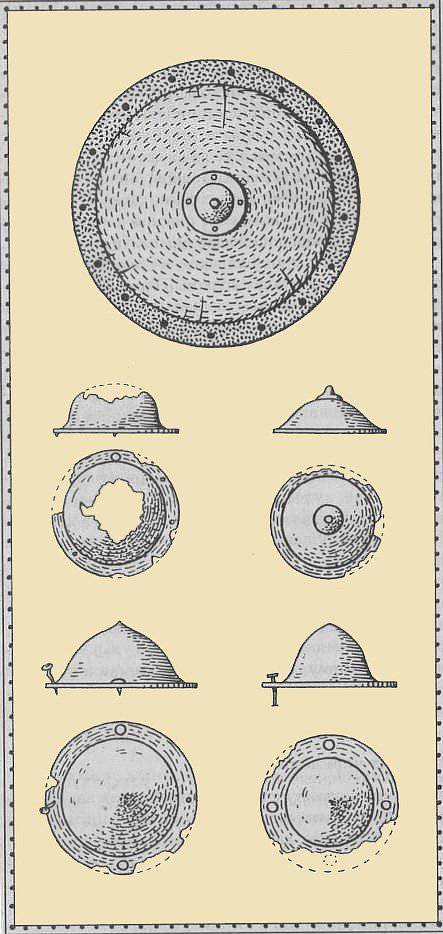
Round shield with umbon and main forms of umbon. IX – X century.
In the XI century, the shields become convex. At the same time, massively distributed almond-shaped shields. But round shields do not give up their positions. Almond-shaped shields were massively distributed throughout Europe. Apparently, this was due to the strengthening of the role of cavalry. The almond-shaped shield covered the cavalry warrior from shoulder to knee and was more comfortable for him than round. The height of the amygdalus shield was between a third and a half of human height. These shields were flat or slightly curved along the longitudinal axis. The ratio of height and width was 2: 1. Almond-shaped shields, like round ones, were made of wood and leather, bound around the edges and had an umbron.
Shields are usually painted and decorated. In the XII century, these were the emblems and symbols of princely families. On the images of holy warriors shields were decorated with crosses. In an earlier era, shields were apparently decorated with sacred symbols, signs of a clan, a tribe. The background of the shield was painted. It is known that the Russians preferred red.
In ancient Russia, the shield was a prestigious weapon. Early sources mention the shield in third place, immediately after the sword and spear. Suffice it to recall that among the pagan Slavs, the Sun itself (Dazhbog Svarozhich) was a fiery golden shield. The Prophet Oleg hung his shield as a sign of patronage at the gates of Constantinople. Shields Rusa swore, fastened treaties. The dignity of the shield was protected by the Russian Truth - a man who dared to steal the shield, spoil it, had to pay a considerable fine. Loss of shield in battle was a symbol of complete defeat and defeat.
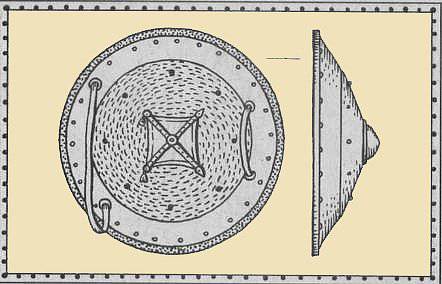
The inner side of the round shield and its side view. XII – XIII century
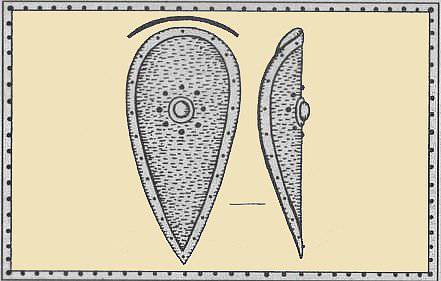
Almond-shaped shield and its side view. XI - the beginning of the XIII century
Warrior's Clothing
Tissue and leather in the earth are poorly preserved; for this, special conditions are needed, such as the marshes of the Novgorod land, which have preserved many items of ancient Russian life. Images of ancient Rus also a little. Better preserved metal objects - weapons, some details of clothing, such as buckles, buttons and brooches (cloaks cloaks and shirts). For some such details, scientists restore the overall look of clothing. In addition, researchers, due to lack of sources, often refer to the materials of neighboring peoples - residents of Scandinavia or Steppe. Later Russian ethnographic materials - 18 - of the beginning of the 20 centuries also attract, since the tradition of clothing has been preserved until that time.
The complex of men's clothing included a shirt, pants and a raincoat. They wore leather shoes on their feet, hemispherical hats with fur bands around their heads. Clothes were sewn from linen and wool. In addition, expensive foreign silk was popular in the squad environment.
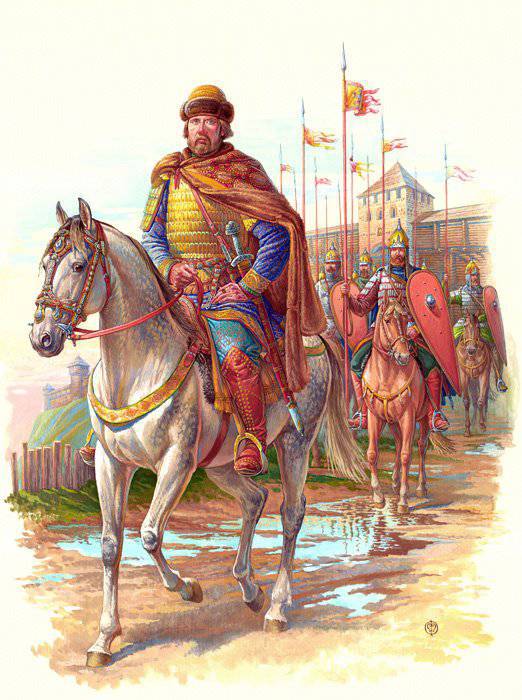
Russian prince with retinue. The first half of the XI century. According to the archaeological finds of Kiev, Chernigov and Voronezh region. Source: Warriors of the Epoch of the Ancient Rus of the 10th - 11th centuries in the drawings-reconstructions of Oleg Fedorov.
A mandatory part of the old Russian costume was a leather belt with metal details. Belts, which were decorated with metal plates, are called by archaeologists as a dial. The heyday of Russian typesetting belts came in the X century. However, later they were not out of use. In particular, belts with precious metals are mentioned in princely spiritual credentials (wills) of the 14th - 15th centuries. This belt was a symbol of the high position of a warrior in society. Sometimes in the burials there are complex belts, with several types of plaques, the total number of which can reach several dozen. The plaques of belts of the most varied forms and have a different ornament: trefoils, crin-lilies, geometric figures, vegetative curls, etc. Knives were hung from the belt, small handbags decorated with plaques or chased plates. Usually such bags were small - 12 - 14 cm in length and width.
Pants were the type of trousers. The wearing of such sharovars by the Slavs — wide, assembled at the knee’s assembly — is mentioned by an oriental scholar of the beginning of the 10th century, Ibn Ruste. Such wide pants were comfortable for riding.
There is practically no data on shoes. Apparently, Russian warriors wore leather boots, semi-boots and boots, typical of that era. In inclement weather and in winter, shoes were worn with a shoe in the form of shoe spikes. The early boots had a low, straight shaft of the two halves — the front and the back. Later, more sophisticated boots appeared - with a shaft that widened upwards and was cut from several pieces. Sock sharpened, and the sole was made multi-layered. In the 14 century, a small heel appeared at the boot.
They wore a “Russian fur hat,” known from the Scandinavian sagas, on their heads. Perhaps it had a bell-shaped form with a fur trim; such caps were widely distributed in the steppe zone. Apparently, this cap is described by Oriental authors: “They (the Ruses are the author) tend to wear wool caps with a dangling tail to the back of the head”. And Ibn Fablan mentions a brocade hat, trimmed with sable.
Little is known about the ancient Russian cloaks, outerwear, which protected the person from the weather. The form of a raincoat is restored according to the images of princes that have come down on book miniatures, coins, seals. She was close to a semicircle, or a sector of a circle of about 140-160 degrees. Perhaps, on one side, a trim was made (a small triangular section of the fabric was cut out, and then the edges of the incision were sewn together), thanks to which the raincoat fitted the shoulders tightly. The cloak was fastened with a special fastener - fibula, which was located on the chest or on the side, under the right arm.
The suit of the Russian warrior included a caftan. This swing clothing, which is comfortable for a horseman, was distributed from ancient times from the Middle East to the steppe zone of Eurasia. Kaftans in Russia in the 10 century are found precisely in the monuments of the Russian military culture - the barrows of Gnezdov, Timerev, and burial grounds near Chernigov. The closest relatives of Russian caftans are Alan caftans. The Alan caftans, depending on the wealth of the owner, were made of silk or linen. Some caftans were lined with fur. Russian caftans, given the more severe climatic conditions, apparently, were made of wool. This is confirmed by the find in one of the barrows of Gniezdov - the top of the caftan was woolen, and the lining was leather.
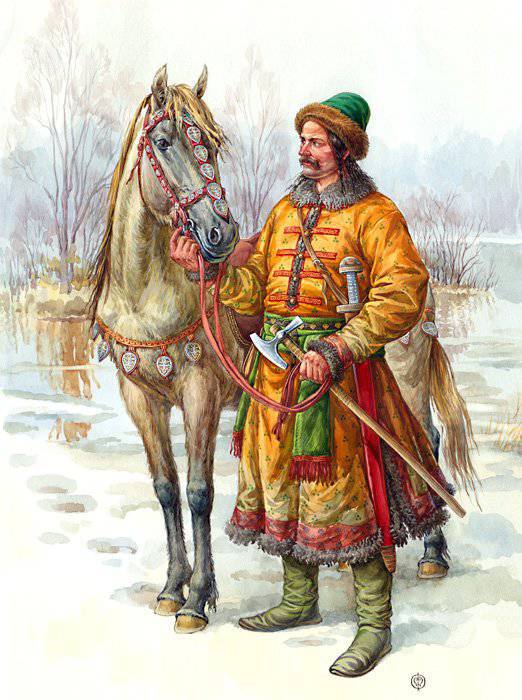
Kiev combatant X century. According to the excavations MK Karger Tithe Church in Kiev.
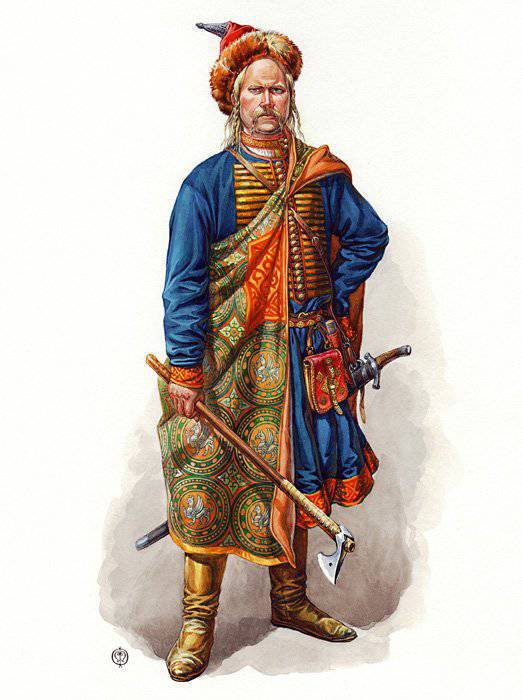
Notable warrior squad Rus. The end of X - the beginning of the XI century. According to the materials of the burials of the Shestovitsa burial ground, Chernihiv region.
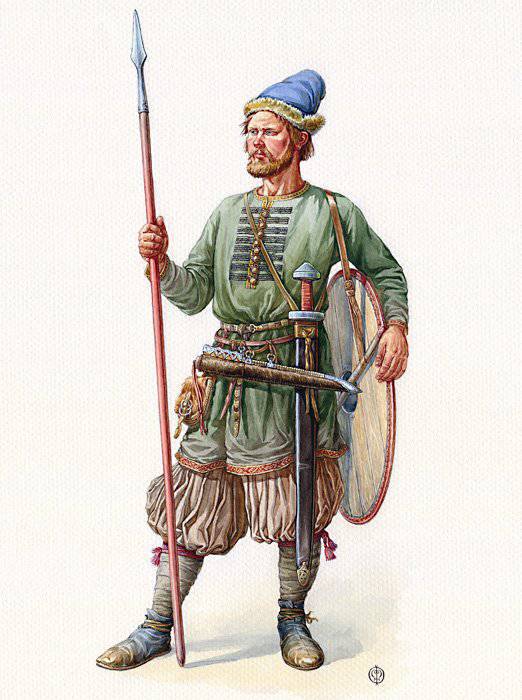
Old Russian warrior. The second half of the X century. According to the materials of T.A.Pushkina, Smolensk region, Gnezdovsky archeological complex.
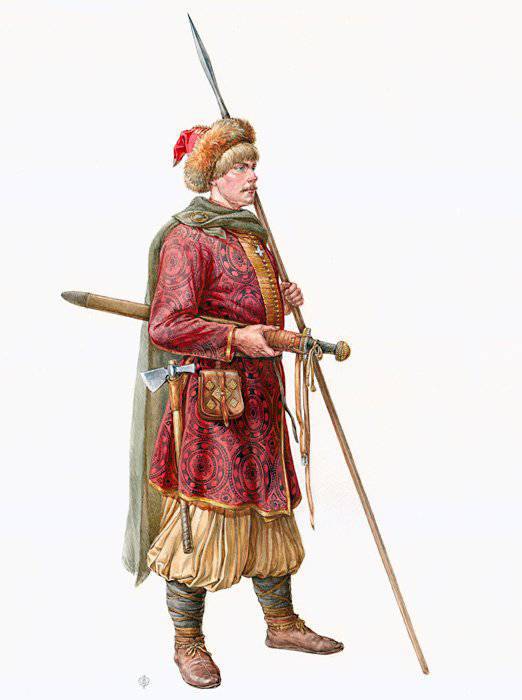
Old Russian warrior in a swing coat with fabric. The second half of the X century. According to the materials of T.A.Pushkina, Smolensk region, Gnezdovsky archeological complex, burial day DN-4.
To be continued ...
Information